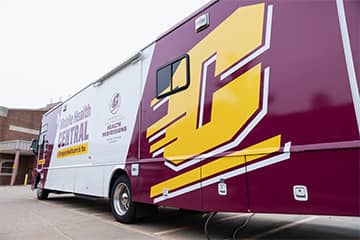CMU professor’s mask project passes the test
Study finds masks made through global partnership as effective as commercial products
Lana Ivanitskaya's masks have passed the test.
The Central Michigan University School of Health Sciences faculty member developed an international partnership to scientifically design, hand-make and distribute face masks to protect against COVID-19 infection. More than 1,600 of the masks already have been distributed, mostly to the Navajo Nation in Arizona and New Mexico.
Now Ivanitskaya is happy to report the masks performed as well as commercially available masks in a CMU-funded study by Stanford University and World Health Organization researchers. The masks' three layers filter at least as well as recently tested commercially available masks. They also are more breathable than the best commercial mask tested, which likely contributes to mask wearing compliance. And filtration efficiency did not appear to change much after the reusable masks were washed a few times.
"We conducted material testing only, but we have many reasons to believe that our mask fit is also superior," Ivanitskaya said. "Our masks were specifically designed to fit the face tighter than commercial medical/surgical face masks."
The mask project's functional designer is a CMU alum with Armenian roots: Armine Ghalachyan, a faculty member in apparel, merchandising, design and textiles at Washington State University. The project also includes Ali Alvarez, an industrial hygienist and CMU Master of Health Administration degree student from Florida; and Julia Kalusniak, a CMU Honors Program student.
Ivanitskaya reached out to Amish seamstresses in Mecosta County, Michigan, to sew the scientifically designed masks. Midland-based Express Employment Professionals funded the Amish labor.
"As we continue our research and manuscript preparation, I am distributing masks to the people who need them the most," Ivanitskaya said. "I currently have 200-plus masks sewn by the local Amish from the materials we just tested that may be particularly useful to community members with hearing aids."
The masks don't interfere with hearing aids because they stay in place with a head loop and two straps that tie in the back of the head. The tested masks also feature:
- Three filtration layers, two layers of soft polypropylene with a middle filtering layer suggested by Peter Tsai, an N95 respirator mask inventor.
- A cup shape that is roomy and easier for talking.
- A bendable nose strip to fit the face and avoid fogging glasses.
- A tighter fit than surgical masks, offering protection for self as well as for others.
- The ability to be worn around the neck when not needed.



